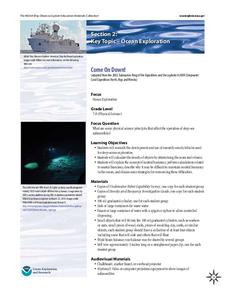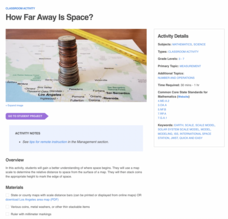Curated OER
Sets Of
Represent multiplication as sets of items for beginners to this concept. They look at six familiar object sets and determine the total number of legs by counting the sets. There is some scaffolding here, as the first is done for them and...
Curated OER
Symmetry
Is this the line of symmetry? Scholars analyze 12 images to determine whether or not the dotted line in each reflects symmetry. There are three examples for them to reference before they start, so consider reviewing these together before...
NOAA
Come on Down!
What do we do when a dive is too dangerous for humans to accomplish? Send in the robots! Middle school scientists get acquainted with several different models of submersible robots in the second instructional activity of six from NOAA....
Curated OER
Practicing Letters e and f
Which of these words begins with the letter e? Scholars become familiar with lowercase letters e and f by visually matching. After tracing each letter, they draw lines from the letter to images beginning with the same sound. Encourage...
Curated OER
Multiplication as Repeated Addition
For beginners, present multiplication as repeated addition to give them a familiar context. They examine grouped sets of objects and add up the groups to get a total. Then, learners translate the addition sets to a basic multiplication...
Curated OER
Science: Floating and Sinking Objects
Second graders discuss why some objects float while others sink. They examine various objects and predict whether or not they will sink or float. Students discover the properties needed for objects to float.
Curated OER
Combining Direct and Indirect Object Pronouns
Students combine direct and indirect pronouns in this instructional activity. They practice with rewriting sentences when a direct and indirect object is present. They create a story using PowerPoint with their new sentences.
Curated OER
Translucent, Transparent and Opaque Objects
Students examine different objects. For this appearance lesson, students watch a video about translucent, transparent and opaque objects. Students work in pairs to examine a bag of objects and then discuss the results.
Curated OER
Play I Spy
Pre-readers examine a rainy-day picture with many details to find words beginning with either p, u, w, or l. They tally the number of objects they find and write the numbers beside each letter. To help kids stay organized and meet...
Curated OER
Odd One Out
Which of these is different? Pre-readers examine four pictures of familiar objects. Each picture has a row of images following it, and they must determine which of them is different. Once youngsters have figured it out, they circle the...
Illustrative Mathematics
3-D Shape Sort
From the apple on your desk and the coffee cup in your hand, to the cabinets along the classroom wall, basic three-dimensional shapes are found everywhere in the world around us. Introduce young mathematicians to the these common figures...
Teach Engineering
What is a Nanometer?
Teams learn about the size of a nanometer by measuring objects and converting those measurements. A worksheet then tests the groups' abilities to use nanometers by having them determine the size of objects that are too small to measure.
Teach Engineering
Density Column Lab - Part 2
Groups suspend objects within layers of liquids to determine the densities of different liquids and compare them to the densities of objects calculated in Part 1. The groups then carefully test their calculations by layering the liquids...
University of Colorado
Spacecraft Speed
Space shuttles traveled around Earth at a speed of 17,500 miles per hour, way faster than trains, planes, or automobiles travel! In the 13th installment of 22, groups graph different speeds to show how quickly spacecraft move through...
Curated OER
New Names
Students list names of common products such as cars, and share ideas about how and why those names might have been selected. They find the origins of names for new products. Students create a chart of old and new names for familiar objects.
Curated OER
Impact of Inventors
Young scholars examine the impact of inventors on our world. In this science lesson, students are given a time line of the invention of familiar objects. Young scholars then evaluate some kid inventors and decide if they would make...
Curated OER
Measure the Length Word Problems
As you begin explaining measurement with consistent units, scholars can use this to practice before they are introduced to more complicated systems (i.e. a ruler). They measure five familiar objects against a row of boxes, which serve as...
Curated OER
Comparing Fractions with Like Numerators or Denominators
There are five fraction models here and each has a corresponding numeric fraction it represents. Scholars use the models to better comprehend fractions as they match each to its correct numeric form. Although all of these fractions could...
Curated OER
Change It
Fourth graders expand their knowledge about how the physical properties of a substances can be changed. They are given multiple opportunities, using first-hand experiences and familiar objects in different contexts, to identify...
Curated OER
Objects in the Sky
Students explore what the sky looks like at different times. They identify objects in the sky and recognize changes over time. Students observe the sky and look for objects that are common in both the daytime and the nighttime sky.
Charleston School District
Volume of Rounded Objects
How much can different shapes hold? The answer varies depending on the shape and dimensions. Individuals learn the formulas for the volume of a sphere, cone, and cylinder. They apply the formulas to find the volume of these...
NASA
How Far Away Is Space?
Space is about 60 miles from the surface of Earth. Pupils make calculations to model that distance by stacking coins the appropriate height using scale. They then explore the distance to objects in space such as satellites and the space...
Curated OER
Introduction to Objects
Students are introduced to the concept of Objects in Programming and identifying the parts of an object. They view the radio objects movie and then brainstorm household objects that can be represented as a series of controls and displays.
Teachers.net
Figurative Language
When is a staple remover a fanged monster? In your ELA classroom when you're teaching this fun figurative language lesson, of course! Get your young writers using figurative language by making a game of it. Give groups a paper bag full...

























